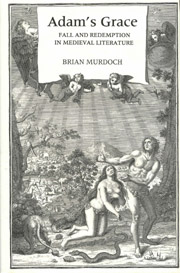Book contents
- Frontmatter
- Contents
- Ursula
- Preface
- Dedication
- Introduction: Interpreting Adam
- One After Eden: the Apocryphal Adam
- Two Written in Tablets of Stone: Adam and Gregorius
- Three Stultus et Insipiens: Adam, Parzival and the Knowledge of God
- Four Innocent Blood: Redemption and the Leper
- Five Promises to Adam: the Fall, the Redemption and Medieval Drama
- Six By the Scriptures Alone? Playing Adam in the Reformation and Beyond
- Bibliography
- Biblical Index
- General Index
Five - Promises to Adam: the Fall, the Redemption and Medieval Drama
Published online by Cambridge University Press: 12 September 2012
- Frontmatter
- Contents
- Ursula
- Preface
- Dedication
- Introduction: Interpreting Adam
- One After Eden: the Apocryphal Adam
- Two Written in Tablets of Stone: Adam and Gregorius
- Three Stultus et Insipiens: Adam, Parzival and the Knowledge of God
- Four Innocent Blood: Redemption and the Leper
- Five Promises to Adam: the Fall, the Redemption and Medieval Drama
- Six By the Scriptures Alone? Playing Adam in the Reformation and Beyond
- Bibliography
- Biblical Index
- General Index
Summary
AT THE START OF A PLAY written in 1527 and performed before King John VIII of Portugal and Queen Catherine in Almeira, and entitled (without undue modesty) Breve sumário da história de Deus, a brief summary of the divine plan, the Spanish/Portuguese dramatist Gil Vicente announced his theme:
E porque o tenor
da resurreição de nosso Senhor
tem as raizes naquele pomar,
ao pé, d'aquela árvore que ouvistes contar,
onde Adão se fez pecador,
convém se lembrar.
(It is well to remember why the essence of our Lord's resurrection has its roots in the same orchard, at the foot of the tree from which, as you have heard tell, Adam became a sinner.)
More extensive medieval literary representations of Genesis in prose or verse usually indicate the promise of a Redemption, and medieval Gospel-poems often begin with a reference, sometimes quite a detailed one, to the Fall. Such references to the Redemption at the time of the Fall are sometimes made intrinsically, that is, not as an authorial aside, but within the time-frame of the action – by God himself to Adam, for example. The possibility of authorial comment is always there, however, sometimes as a comforting reminder of Old Testament typology.
The simultaneity of the divine economy in a sub gratia world and the causal and allegorical parallelism of the Fall and the Redemption are more difficult to demonstrate and comment upon in visual forms like iconography or the drama.
- Type
- Chapter
- Information
- Adam's GraceFall and Redemption in Medieval Literature, pp. 126 - 151Publisher: Boydell & BrewerPrint publication year: 2000



